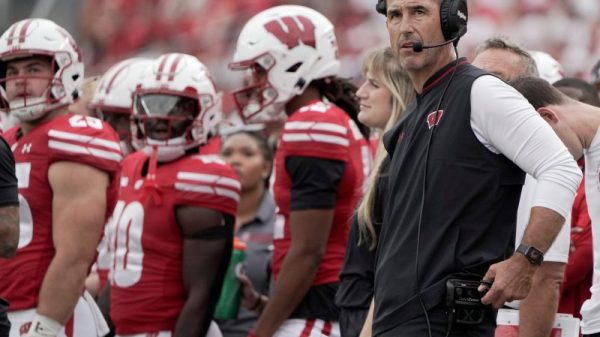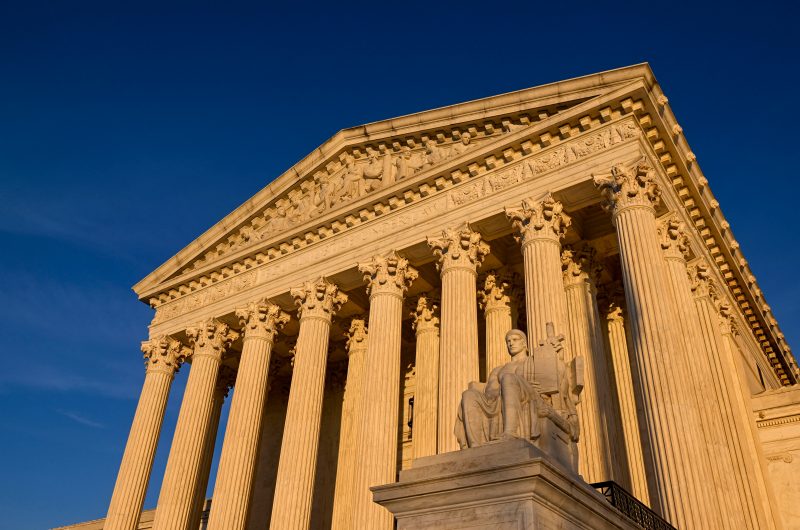A divided Supreme Court said Thursday that the Alabama legislature drew congressional districts that unlawfully diluted the political power of its Black residents, an unexpected decision from a court that recently has been more skeptical of the Voting Rights Act’s protections.
The 5-4 decision, written by Chief Justice John G. Roberts Jr., bucked the court’s recent trend of rulings that weakened provisions of the landmark 1965 act. He was joined by fellow conservative Justice Brett M. Kavanaugh and the court’s three liberals, Sonia Sotomayor, Elena Kagan and Ketanji Brown Jackson.
They upheld a decision by a three-judge panel that threw out Alabama’s maps for its seven congressional districts, which included only one with a majority of Black voters even though African Americans make up more than a quarter of the state’s population.
“We see no reason to disturb the District Court’s careful factual findings,” Roberts wrote, adding that Alabama was asking for a radical rewrite of the court’s precedents.
The decision likely means a second Democrat could be elected from the state — its delegation is now one Black Democrat and six White Republicans. And it will likely boost challenges of maps drawn by Republican-led legislatures elsewhere; federal judges in Georgia and Louisiana have found similar violations in maps from those states.
It was a surprise from a court whose conservative majority had signaled it was suspicious of some sections of the Voting Rights Act, and was thought to be sympathetic to Alabama’s argument that the court’s precedents improperly required legislatures to prioritize race over traditional redistricting techniques.
Supreme Court 2023 decisions
End of carousel
Instead, Thursday’s opinion in effect preserves the status quo that has been in place for 40 years.
“The heart of these cases is not about the law as it exists,” Roberts wrote. “It is about Alabama’s attempt to remake our … jurisprudence.”
But the decision is notable from Roberts, who famously said in one of his early decisions in a redistricting case that “it is a sordid business, this divvying us up by race.” In Thursday’s case, he acknowledged concerns that abiding by the court’s guidance “may impermissibly elevate race in the allocation of political power within the States.”
“Our opinion today does not diminish or disregard these concerns,” he wrote. “It simply holds that a faithful application of our precedents and a fair reading of the record before us do not bear them out here.”
Civil rights groups had braced for another defeat at the court, and called the ruling a welcome surprise.
“This decision is a crucial win against the continued onslaught of attacks on voting rights,” said Legal Defense Fund Senior Counsel Deuel Ross, who argued the case before the court in October. “Alabama attempted to rewrite federal law by saying race had no place in redistricting. But because of the state’s sordid and well-documented history of racial discrimination, race must be used to remedy that past and ensure communities of color are not boxed out of the electoral process.”
Attorney General Merrick Garland said the decision “preserves the principle that in the United States, all eligible voters must be able to exercise their constitutional right to vote free from discrimination based on their race.”
Alabama Attorney General Steve Marshall (R) said the ruling was disappointing but that the state will continue the litigation in a lower court.
“The Court made clear that its ruling was based only on the preliminary injunction record compiled in just a few weeks before the January 2022 district court ruling,” Marshall said in a statement. “The State is still entitled to put on our full case at trial, and we are confident that the evidence will make clear that voters in Alabama, regardless of their race, have the same opportunity as any other members of the electorate to participate in the State’s political processes and elect representatives of their choice.”
The ruling drew a sharp rebuke from Justice Clarence Thomas, who wrote that the question is whether the Voting Rights Act “requires the State of Alabama to intentionally redraw its longstanding congressional districts so that black voters can control a number of seats roughly proportional to the black share of the State’s population.”
The law, he said, “demands no such thing, and, if it did, the Constitution would not permit it.”
Thomas was joined in parts of his dissent by Justices Samuel A. Alito Jr., Neil M. Gorsuch and Amy Coney Barrett.
Those four, plus Kavanaugh, had earlier put the lower court’s decision on hold. Because of that, Alabama conducted the 2022 elections using its newly drawn maps.
Alabama was challenging a unanimous decision by a three-judge panel that said the Voting Rights Act required the state to create a second congressional district, out of seven, in which an African American candidate would have a good chance of being elected. Alabama’s electorate is 27 percent Black. Those who sued the state alleged that many of those voters are illegally packed into one district, with the rest spread among others so that their voting power is diluted.
The three lower-court judges who ruled against Alabama — two of them nominated by President Donald Trump — were applying Section 2 of the Voting Rights Act, which forbids practices that would mean racial minorities “have less opportunity than other members of the electorate to participate in the political process and to elect representatives of their choice.” The judges concluded Alabama lawmakers should have drawn a second district “in which Black voters either comprise a voting-age majority or something quite close to it.”
The case is the first in which current Supreme Court justices have considered how to apply the Voting Rights Act to districts drawn with racial representation in mind. In 2019, the court said federal courts had no role in policing partisan — as opposed to racial — gerrymandering.
To challenge a redistricting map, plaintiffs must show that there is a minority community large and compact enough to warrant a district. Then it must show racially polarized voting patterns. The panel of judges in the case at issue said it was not a “close call”: “Black voters have less opportunity than other Alabamians to elect candidates of their choice to Congress.”
The fight centers on what is called the state’s Black Belt, which is named for its fertile black soil but also is an area in which many of the state’s Black voters live. The challengers’ maps would remove some of those voters from the district that now routinely elects a Black congresswoman and create a second district in which a Black candidate would have a much greater chance.
Thomas seemed disappointed that the court’s conservative majority had not coalesced on his long-held view that the Constitution forbids extensive use of race in making redistricting decisions. He said that the lower court’s interpretation of Section 2 of the Voting Rights Act would mean it is “nothing more than a racial entitlement to roughly proportional control of elective offices — limited only by feasibility — wherever different racial groups consistently prefer different candidates.”
But Roberts said Thomas’s complaint that federal courts have been “methodically carving the country into racially designated electoral districts” for decades is simply wrong.
“Proportional representation of minority voters is absent from nearly every corner of this country despite Section 2 being in effect for over 40 years,” Roberts wrote.
As is often the case, Kavanaugh wrote a separate opinion that acknowledged both sides had a point — and said his critical vote might not hold forever.
“Justice Thomas notes … that even if Congress in 1982 could constitutionally authorize race-based redistricting under Section 2 for some period of time, the authority to conduct race-based redistricting cannot extend indefinitely into the future,” he wrote. “But Alabama did not raise that temporal argument in this Court, and I therefore would not consider it at this time.”
The liberal justices, who had vigorously defended Section 2 and the lower court’s decision during oral arguments, did not write separately, and were content to join Roberts’s opinion.
Roberts was in the majority and wrote the opinion in another Alabama case in 2013, Shelby County v. Holder, in which the court dramatically weakened Section 5 of the Voting Rights Act. That section required federal approval of changes to voting procedures in places with a history of discrimination.
In 2021, the conservative majority limited the ability to challenge voting restrictions opposed by minorities in a case from Arizona called Brnovich v. Democratic National Committee.
The current case is Allen v. Milligan.



























